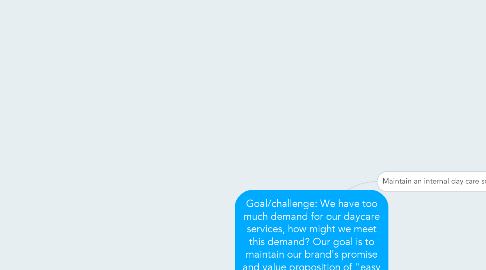
1. Maintain an internal day care service
1.1. Expand day care operations
1.1.1. Build out a secondary space in the building. Upside: Ability to provide consistent, quality childcare in the long run. Downside: Large upfront investment cost. We will have to acquire and retain more customers to reach break-even/earn a profit
1.1.2. Renovate the current space to make it more efficient and accommodate more kids. Upside: Lower fixed cost compared to a brand new space. Higher profitability and more capacity in the long run. Downside: Interrupted service. Maybe just a short term fix and demand might outpace this upgrade.
1.1.3. Buy local day care provider and operate as an extension of our brand. Upside: Increase knowledge-base of organization, easily acquire ready to operate space, building out brand Downside: capital required to purchase, challenging to manage two properties.
1.1.4. Hire residents to become the providers. Serve as nannies for the kids without expanding the space. Upside: Additional capacity w/o fixed costs. Fostering a sense of community and creating job opportunities for the residents. Downside: Inconsistent service, safety, reliability.
1.2. Keep the day care as is and have a waiting list for new clients
1.2.1. Use seniority to determine how people are prioritized on the waiting list. Upside: Promote loyalty. Lower risk than attempting to change the existing daycare. Downside: Dissatisfied customers who have to wait.
1.2.2. In the interim, residents will have an option to pay for a nanny share Upside: They prefer nannies and in the long term we have a balance between options for a daycare or a nanny-share. Downside: They prefer nannies over daycares and lower demand for our daycare.
1.2.2.1. In the long-term split childcare services between a daycare or a nanny share. Downside: More decentralized, more risk and need for oversight when you have so many providers.
1.2.3. Refer to qualified day care partners in interim Upside: Potential new revenue stream and no loss of future clients Downside: May lose market share, brand of partner may be inconsistent may become inconsistent with our mission

